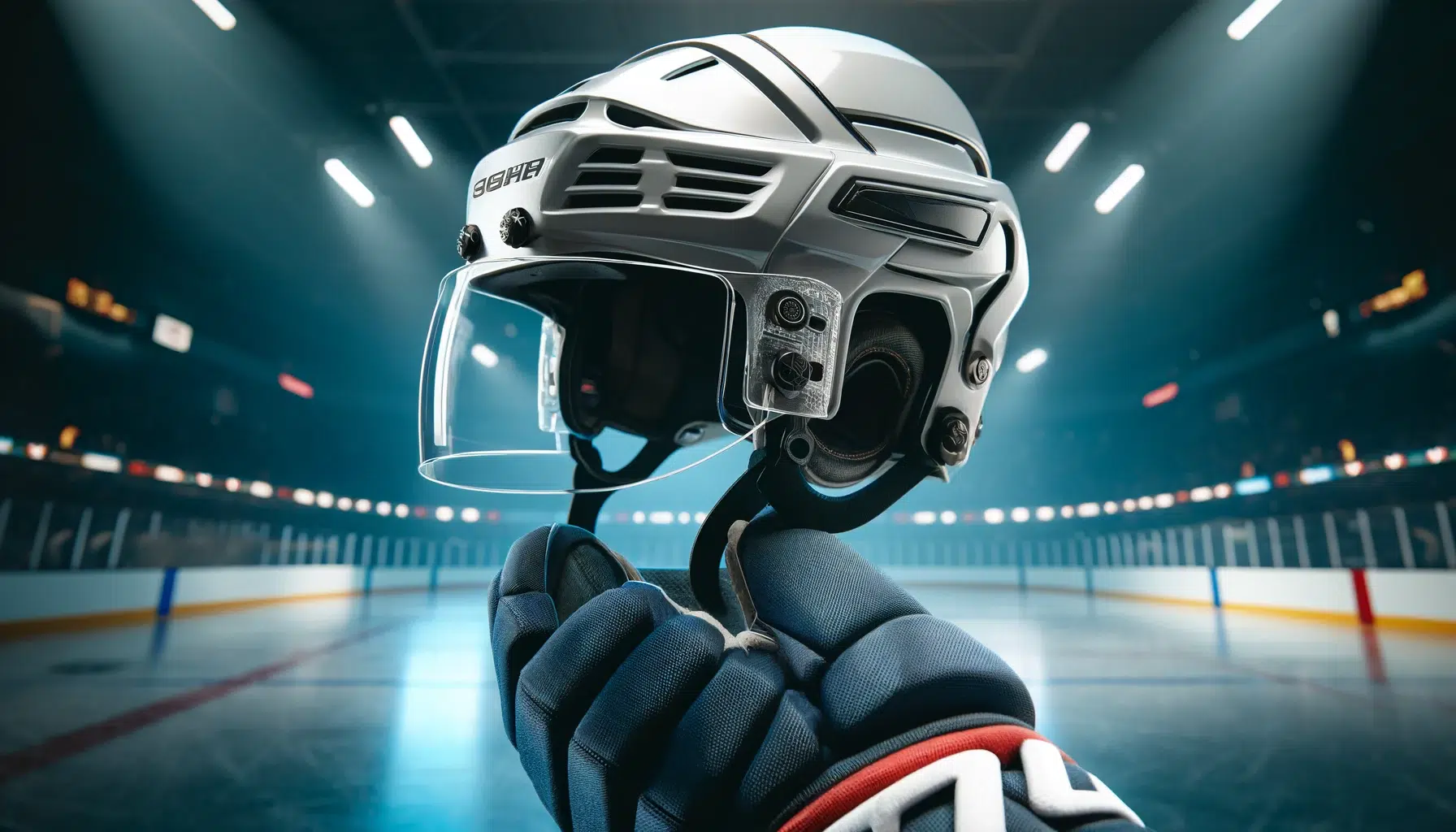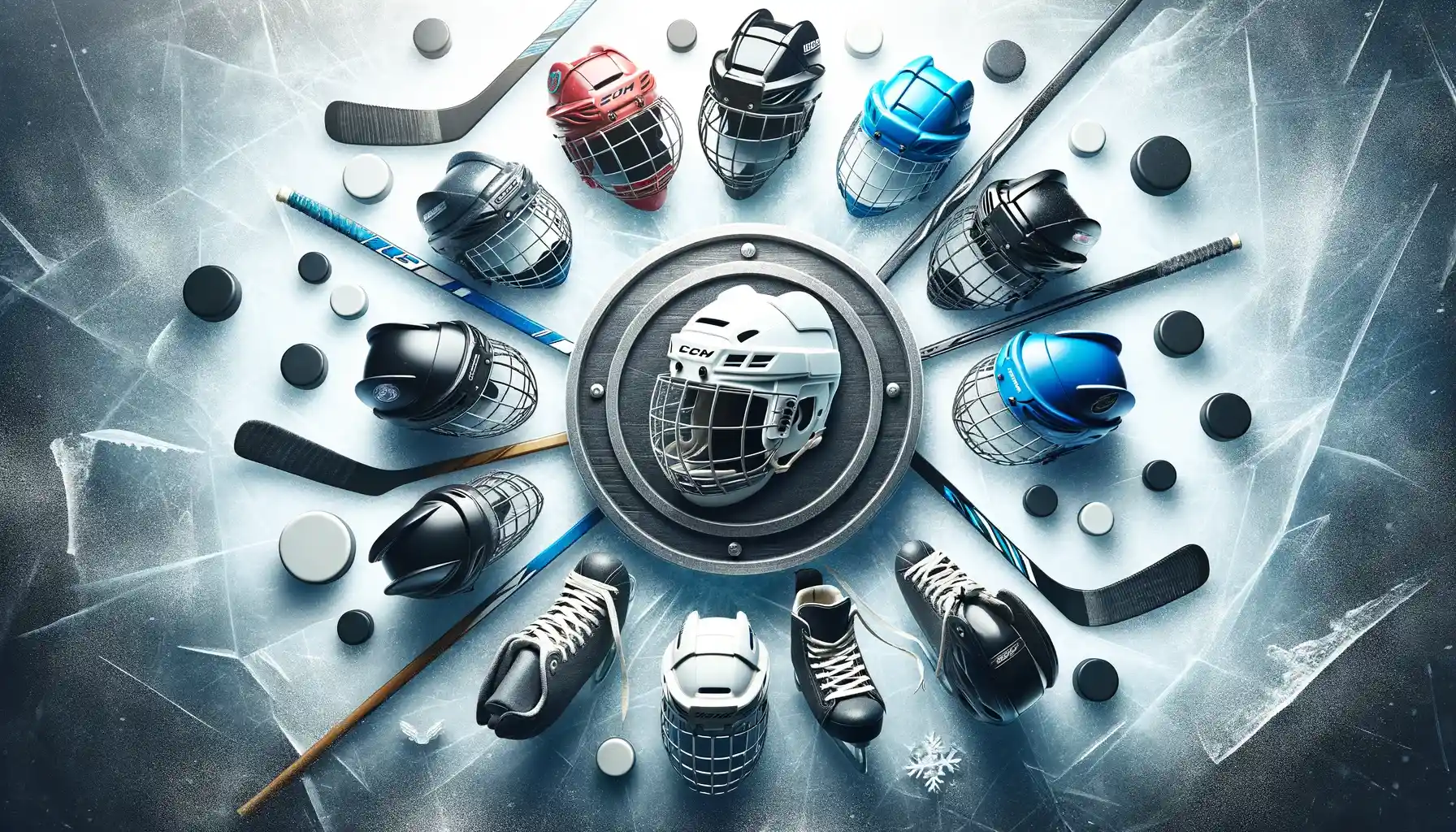Ice Hockey is a fact-paced and high-impact sport in which collisions, flying pucks, and swinging sticks are very common. In such an environment, wearing a helmet is crucial for player safety. Helmets are very beneficial for shielding players from head injuries, concussions, and facial injuries. In addition to preventing serious injuries they also contribute in improving overall performance by giving players the self-assurance to concentrate on their game.
A brief history of hockey helmets
In spite of the fact that the hockey helmets have been in use since the early 20th century, they were not compulsory until the 1970s to use in professional leagues. Early hockey helmets were made of leather and provided minimal protection. With the passage of time, technological advancements and increased awareness of the importance of head protection has contributed towards the improved helmet designs and materials. Today, helmets have become an important hockey equipment that offers enhanced protection, comfort, and performance to players of all levels of the game.
Overview of the different types of hockey helmets
A huge selection of hockey helmets are available in the market today and all of them have been customized to specific demands and preferences of the players. Hockey helmets are of various types like traditional hockey helmets, full-face hockey helmets, half-shield hockey helmets, hybrid hockey helmets, and custom hockey helmets. In addition to these helmet types, facial protection options such as visors and cages also there which play a crucial role in ensuring player safety. Choosing the right helmet and facial protection is essential for players to prioritize safety and comfort on the ice.
I have added a table below which includes the four main types of Ice hockey helmets: full cage, half shield, full shield, and hybrid shield. There are other types of helmets available such as goalie masks and specialized helmets for players with certain medical conditions or disabilities, but these are not as commonly used.
Comparison of Different Types of Hockey Helmets and Their Best Uses
| Type of Hockey Helmet | Description | Best For |
|---|---|---|
| Full Cage Helmet | A metal cage that covers the entire face, including the eyes, nose, and mouth. | Beginner and youth players, or players with a history of facial injuries. |
| Half Shield Helmet | A plastic shield that covers the eyes and nose, but leaves the mouth exposed. | Intermediate to advanced players who want more visibility and breathing room. |
| Full Shield Helmet | A clear plastic shield that covers the entire face, including the eyes, nose, and mouth. | Players who want maximum protection and visibility, but do not like the restricted feeling of a full cage. |
| Hybrid Shield Helmet | A combination of a half shield and a full shield, with a clear plastic shield that covers the lower part of the face and a metal cage that covers the upper part. | Players who want both the protection of a cage and the visibility of a shield. |
Traditional Hockey Helmets
Traditional hockey helmets are characterized by a hard outer shell, a foam liner for impact absorption, and an adjustable chin strap for a secure fit. These type helmets do not come with built-in facial protection, and therefore you need to purchase them separately. Many traditional helmets feature ventilation holes for improved airflow and comfort during play.
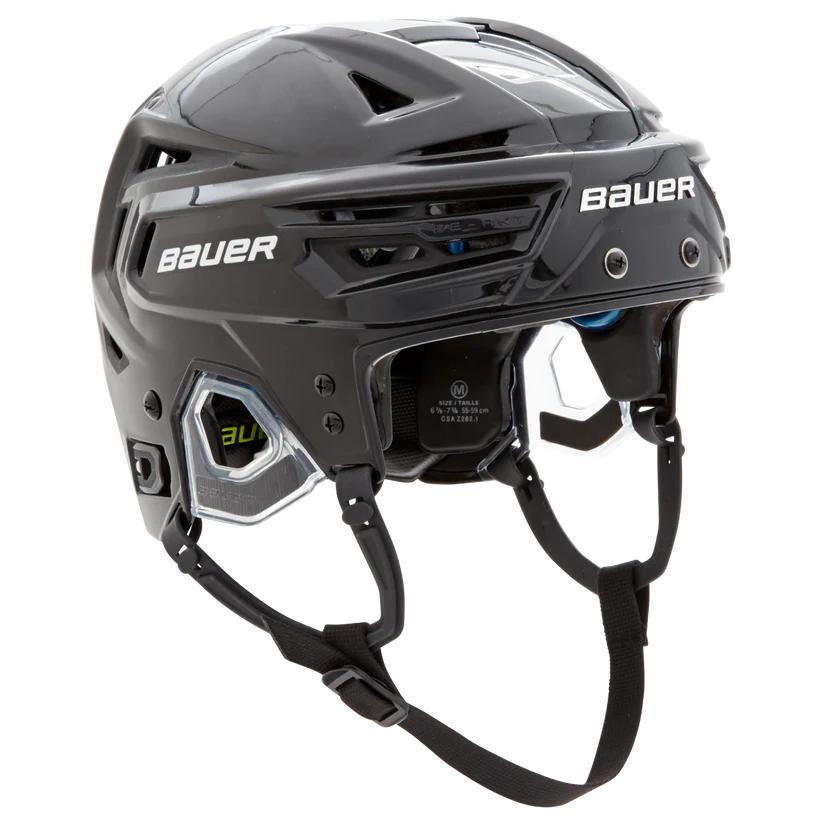
Materials used in traditional hockey helmets
The traditional hockey helmets have the outer shell made from high-impact resistant plastic, like polycarbonate or ABS (acrylonitrile butadiene styrene). These materials offer excellent durability and protection. The inner foam liner, which absorbs the energy of impacts, is commonly made from expanded polypropylene (EPP) foam or vinyl nitrile foam. Both materials provide good shock absorption and energy dispersion, with EPP foam offering better durability and vinyl nitrile foam providing a softer, more comfortable feel.
Advantages and disadvantages of traditional hockey helmets
Advantages:
- Traditional Ice hockey helmets provide a solid level of protection for the head from impacts and collisions.
- These helmets are more affordable for players of all levels since these are usually less expensive as compared to other types of helmets.
- Ventilation holes help keep players cool and comfortable during gameplay.
- The adjustable chin strap allows for a customizable fit.
Disadvantages:
- Traditional hockey helmets do not come with built-in facial protection, which must be purchased separately, adding to the overall cost.
- Some players may find the level of protection provided by traditional helmets to be insufficient, particularly in high-contact situations or positions.
- As compared to other types of ice hockey helmets, traditional helmets may give less coverage and padding that could increase the risk of injury.
Full-Face Hockey Helmets
Full-face hockey helmets provide comprehensive protection by featuring a built-in cage or shield that covers the entire face. These helmets have been specially designed to provide the highest level of protection from impacts, collisions, and flying items like pucks and sticks. Like traditional Ice hockey helmets, full-face helmets have a hard outer shell, foam liner, and adjustable chin strap, as well as ventilation holes for added comfort during play.
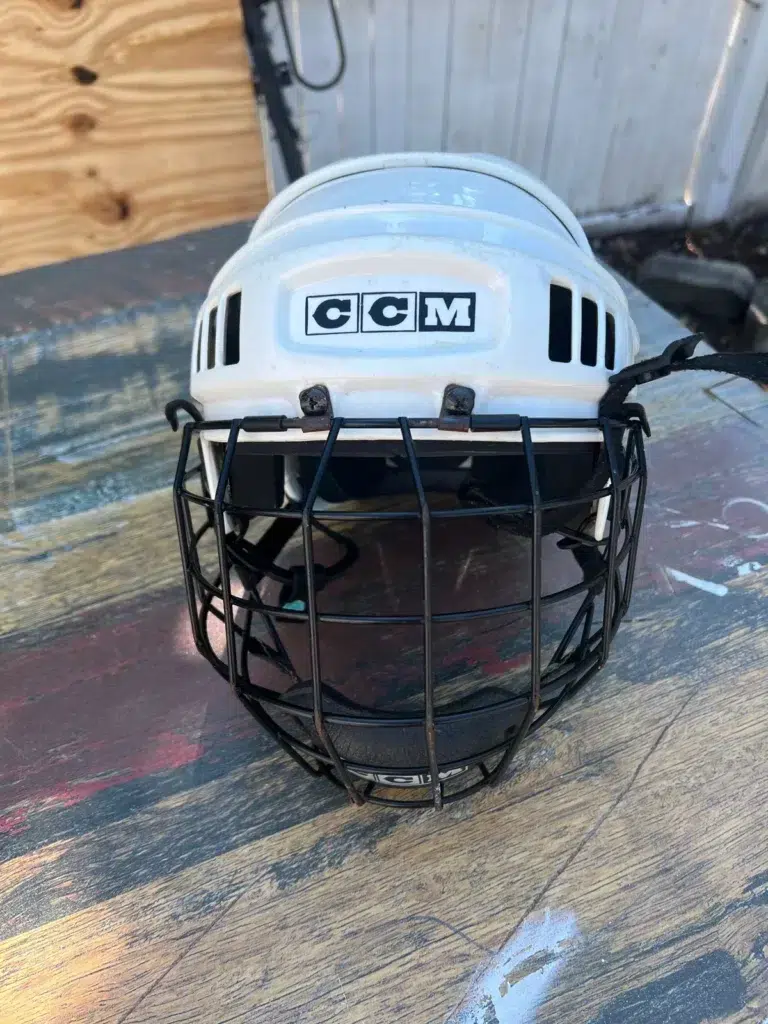
Materials used in full-face hockey helmets
Full-face hockey helmets and traditional helmets both are made from the same materials. The outer shell is usually made from high-impact resistant plastic, like polycarbonate or ABS. The inner foam liner is commonly made from EPP foam or vinyl nitrile foam, both of which provide excellent shock absorption and energy dispersion.
The facial protection component, which can be either a cage or a clear shield, is made from materials designed to withstand high-impact forces. Cages are usually made of durable and lightweight metals like stainless steel or titanium, whereas clear shields are made of impact-resistant polycarbonate plastic.
Advantages and disadvantages of full-face hockey helmets
Advantages:
- Full-face hockey helmets provide enhanced protection to the face and head, along with lowering the possibilities of facial injuries and dental damage.
- The built-in facial protection eliminates the need to purchase additional equipment, making them a cost-effective option.
- They provide better coverage and padding compared to traditional helmets, offering enhanced protection in high-contact situations.
Disadvantages:
- Some players might find full-face Ice hockey helmets uncomfortable or restrictive as these are heavier and bulkier as compared to the other helmet types.
- Some players may find the cage or shield to be obstructive, reducing visibility and potentially impacting performance.
- The increased coverage may result in reduced airflow and ventilation, causing discomfort or overheating during gameplay.
Half-Shield Hockey Helmets
Half-shield hockey helmets feature a partial facial shield or visor that covers the upper part of the face, primarily protecting the eyes and forehead. These helmets offer a compromise between full-face protection and improved visibility. Like traditional and full-face hockey helmets, half-shield helmets have a hard outer shell, foam liner, adjustable chin strap, and ventilation holes for added comfort during play.
Materials used in half-shield hockey helmets
The materials used in half-shield hockey helmets are similar to those used in traditional and full-face helmets. The outer shell is made from high-impact resistant plastic, such as polycarbonate or ABS, while the inner foam liner is typically made from EPP foam or vinyl nitrile foam.
The half-shield or visor is made from impact-resistant polycarbonate plastic, providing strong protection while maintaining clear visibility. Some visors also have an anti-fog coating to ensure optimal vision during gameplay.
Advantages and disadvantages of half-shield hockey helmets
Advantages:
- Half-shield hockey helmets offer a balance between protection and visibility, allowing players to maintain better vision on the ice.
- Generally these helmets are more comfortable to fit for players as these are lighter and less bulky than full-face helmets.
- The visor provides sufficient protection for the eyes and forehead, lowering the risk of injuries to these areas.
Disadvantages:
- Half-shield hockey helmets do not provide the same level of facial protection as full-face helmets, leaving the lower part of the face more susceptible to injury.
- Some players may find that the visor causes glare or reflections, potentially impacting visibility.
- Since the visor only provides protection to the upper part of the face, extra gear, like a mouth guard, may be required for protecting the teeth and jaw.
Hybrid (Combo) Hockey Helmets
Hybrid or Combo hockey helmets offer a perfect blend of protection, visibility, and comfort as they have been designed by combining the best features of traditional and full-face helmets. These helmets typically feature a hard outer shell, foam liner, and adjustable chin strap, like traditional helmets, but also include a removable cage or shield that can be adjusted for a customized level of facial protection. Hybrid helmets are particularly popular among goaltenders, who require maximum protection for their head and neck while maintaining good visibility.
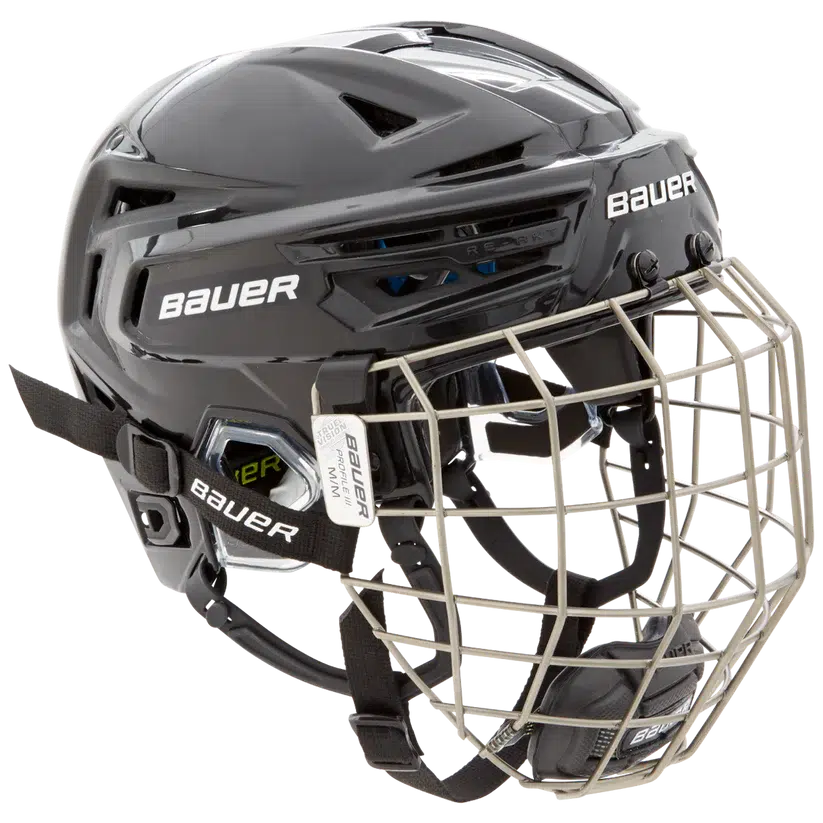
Materials used in hybrid hockey helmets
The materials used in hybrid hockey helmets are similar to those used in traditional, full-face, and half-shield helmets. The outer shell is made from high-impact resistant plastic, such as polycarbonate or ABS, while the inner foam liner is typically made from EPP foam or vinyl nitrile foam.
The facial protection component, which can be either a cage or a clear shield, is made from materials designed to withstand high-impact forces. Cages are usually made of durable and lightweight metals like stainless steel or titanium, whereas clear shields are made of impact-resistant polycarbonate plastic.
Advantages and disadvantages of hybrid hockey helmets
Advantages:
- Hybrid hockey helmets provide a customizable level of facial protection, allowing players to adjust the helmet to their specific needs and preferences.
- These helmets offer a perfect blend of protection, visibility, and comfort, which makes them appropriate for different positions and skill levels.
- The removable cage or shield allows players to switch between different types of facial protection, depending on their requirements or the specific game situation.
Disadvantages:
- Hybrid hockey helmets can be more expensive than traditional, full-face, or half-shield helmets due to their additional features and customization options.
- Some players may find that the added features make the helmet bulkier or heavier, which can be uncomfortable or restrictive during gameplay.
- As the cage or shield is removable, there may be a higher risk of equipment malfunction or damage if not properly maintained or secured.
Custom Hockey Helmets
Custom hockey helmets are specially created for meeting the specific needs and preferences of players. These helmets can be tailored in terms of size, shape, padding, and facial protection to provide the perfect fit and optimal protection. Custom helmets often include additional features, such as personalized graphics or team colors, to suit the player’s style. Like other helmet types, custom helmets typically have a hard outer shell, foam liner, adjustable chin strap, and ventilation holes for added comfort during play.
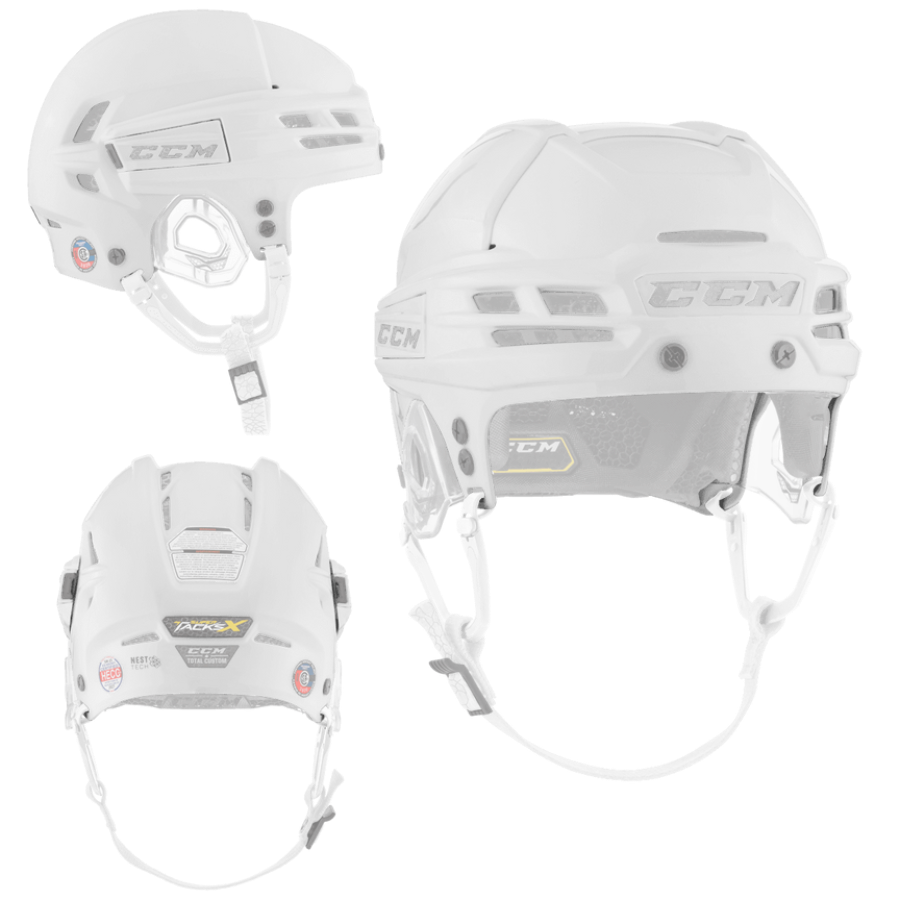
Materials used in custom hockey helmets
The materials used in custom hockey helmets are similar to those used in traditional, full-face, half-shield, and hybrid helmets. The outer shell is made from high-impact resistant plastic, such as polycarbonate or ABS, while the inner foam liner is typically made from EPP foam or vinyl nitrile foam.
Facial protection components, such as cages or shields, are made from materials designed to withstand high-impact forces, including durable, lightweight metals like stainless steel or titanium and impact-resistant polycarbonate plastic for clear shields.
Advantages and disadvantages of custom hockey helmets
Advantages:
- Custom hockey helmets offer a personalized fit and optimal protection tailored to the individual player’s needs, enhancing both safety and performance.
- These helmets allow for greater customization in terms of design and aesthetics, enabling players to showcase their unique style on the ice.
- Custom helmets can be adapted to accommodate specific preferences or requirements, such as additional padding for enhanced comfort or specialized facial protection.
Disadvantages
- Custom hockey helmets can be significantly more expensive than other helmet types due to the additional customization options and tailored fit.
- The process of designing and manufacturing a custom helmet can be time-consuming, which may not be ideal for players who need a helmet quickly or have rapidly changing needs.
- Custom helmets may not be appropriate for sharing among teammates or in the scenarios in which many players require access to the same equipment since they have been made to fit a specific individual.
Fit Types for Hockey Helmets
Properly fitting hockey helmets are essential for safety and comfort, providing optimal protection and allowing players to focus on their performance.
Fit types available
One-size-fits-all helmets: Affordable and simple, but may not fit all head sizes and shapes.
Adjustable helmets: More customizable for better protection and comfort, but can be more expensive and time-consuming to adjust.
Custom-fitted helmets: Offer the best fit and protection, with a high level of customization, but are significantly more expensive and not suitable for sharing.
Every fit type has its own benefits and limitations, so it is important for players to select the one that best suits their demands and preferences.
Learn how to find the ideal hockey helmet with our in-depth Hockey Helmet Sizing guide
Facial Protection in Hockey
| Type of Facial Protection | Description | Best For |
|---|---|---|
| Visor | Clear plastic shield covering eyes only. | Advanced players wanting maximum visibility and minimal obstruction. Note: Some leagues may require a visor to be paired with a mouth guard. |
| Mouth Guard | Moldable plastic piece that fits over teeth and gums. | All players required to wear by most leagues. Offers protection for teeth and gums. |
| Half Shield | Plastic shield covering eyes and nose, leaving mouth exposed. | Intermediate to advanced players wanting more visibility and breathing room. |
| Hybrid Shield | Combination of half and full shield with metal cage and plastic shield, covering lower face and eyes. | Players wanting both protection and visibility. |
| Full Shield | Clear plastic shield covering entire face, including eyes, nose, and mouth. | Players wanting maximum protection and visibility, but not restricted feeling of full cage. |
| Full Cage | Metal cage covering entire face, including eyes, nose, and mouth. | Players with a history of facial injuries or beginner and youth players. |
This table provides an overview of the various facial protection options available in hockey, including full cages, half shields, full shields, hybrid shields, visors, and mouth guards.
Hockey visors and cages
Hockey visors and cages serve as facial protection accessories for players, helping to prevent injuries from impacts, collisions, or flying pucks and sticks. Visors are clear, curved shields made of impact-resistant polycarbonate plastic that cover the eyes and forehead. On the other hand, cages are metal mesh structures that provide full-face coverage, usually made from lightweight and durable materials like stainless steel or titanium.
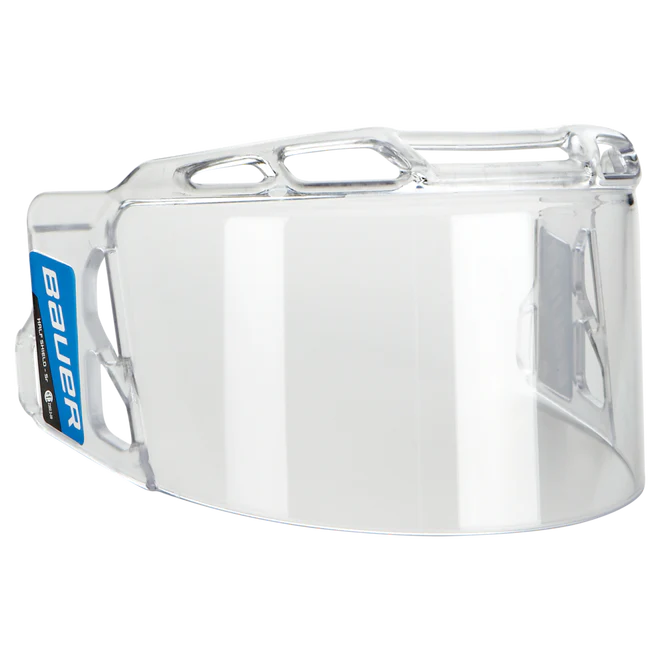
Advantages and disadvantages of visors and cages
Visors: A visor in hockey is a piece of clear plastic or similar material that attaches to the helmet to protect the player’s face and eyes from injury.
Advantages:
- Provide unobstructed visibility for the player
- Lightweight and less restrictive than cages
- Protect the eyes and forehead from impacts
Disadvantages:
- Offer limited facial protection compared to cages
- Can fog up or cause glare under certain conditions
- Require additional protection, such as a mouthguard, for the lower face
Cages: A cage in hockey is a metal or composite wire shield that is attached to the helmet to protect the player’s face and mouth from injuries.

Advantages:
- Offer full-face protection, reducing the risk of facial and dental injuries
- Do not fog up or cause glare like visors
- Provide more coverage for players in high-contact positions
Disadvantages:
- Can obstruct visibility to some extent
- Maybe more restrictive and uncomfortable than visors
- Can be heavier than visors
Rules and regulations regarding facial protection in hockey
Rules and regulations for facial protection in hockey vary depending on the league and level of play. In many youth leagues and amateur associations, full-face protection, such as cages, is required for players under the age of 18. Professional leagues may have different requirements, with some allowing players to choose between visors and cages based on their preferences.
If you want to check other key rules in hockey, read my detailed blog on Ice hockey Rules.
Choosing the Right Facial Protection
Choosing the right facial protection in hockey is essential for preventing injuries. It is important to consider factors such as comfort, visibility, and level of protection when selecting a cage or visor.
Factors to consider when choosing between a visor or cage
- Level of protection required
- Visibility needs and preferences
- Comfort and weight considerations
- League rules and regulations
Recommendations for youth players and high-contact positions
For youth players, full-face protection such as cages is generally recommended due to the increased risk of facial injuries. Additionally, players in high-contact positions, like defensemen or forwards who frequently engage in physical play, may also benefit from the enhanced protection provided by cages.
Learn how to play your position like a pro with my detailed blog post on ice hockey positions.
Common Questions on Hockey Helmets
What is the use of hockey helmet?
Hockey helmets are designed to protect players from impacts, collisions, and falls during games and practices. They are made of hard plastic shells with foam padding on the inside for comfort and shock absorption.
What helmets are used in the NHL?
NHL players use a variety of helmets from different manufacturers, such as CCM, Bauer, Warrior, and True. These helmets meet specific safety standards and regulations set by the league.
What are the three main styles of face masks in hockey?
The three main styles of face masks in hockey are the cage, the shield, and the hybrid shield. The cage is a metal grid that covers the entire face, the shield is a clear full-face visor, and the hybrid shield combines a cage and a visor.
What is different about CCM helmets?
CCM helmets are designed with unique features such as advanced foam padding for comfort and impact absorption, a tool-free adjustment system for a customized fit, and sleek aerodynamic designs. They are popular among professional and amateur players alike.
Selecting the right hockey helmet is important, but so is choosing gear from top brands. Learn more in our comprehensive guide to the top hockey brands to make informed decisions on high-quality equipment that supports your gameplay and safety on the ice.
Conclusion
Choosing the right helmet and facial protection is essential for ensuring player safety and comfort on the ice. A properly fitted helmet and suitable facial protection can significantly reduce the risk of head and facial injuries during play.
Players should always prioritize their safety and comfort when selecting hockey equipment. By choosing the appropriate helmet type, fit, and facial protection, players can focus on their performance and enjoy the game without unnecessary risks or distractions.
I hope you now know and understand about the different types of hockey helmets and facial protection options available. Choose the best option that suits your needs and prioritize safety on the ice.
Let me know what you think in comments below!
When it comes to hockey gear, knowledge is key. Discover the perfect hockey helmet with our guide on How to Buy a Hockey Helmet, explore top-quality options in Hockey Helmet Brands, find the ideal skates with Hockey Skate Brands, and equip yourself with the finest sticks from Hockey Stick Brands. Your gear matters, and we’ve got you covered.
Elevate Your Ice Hockey Skills: Learn, Train, and Succeed!
Unlock the secrets of ice hockey success with our comprehensive selection of guides, covering everything from basic principles to advanced strategies, nutrition, off-ice training, and more. Equip yourself with the knowledge and skills needed to excel on the ice.
- Ice Hockey: A Comprehensive Guide for Beginners
- Ice Hockey Nutrition: Optimize Your Performance with the Right Diet
- Icing in Hockey: Grasp the Concept and Its Impact on Game Strategy
- Off-Ice Training: Boost Your Skills and Conditioning Off the Rink
- Body Checking in Hockey
- Ice Hockey Shooting Guide
- How to Master the Art of Ice Hockey Goaltending: Techniques and Tips for Success
- Ice Hockey Skills: Acquire the Expertise to Dominate the Game
- Ice Hockey Tips: Gain a Competitive Edge with Proven Tactics
- Hockey Clothing Brands: Best Apparel For Ultimate Perfomance
- Ice Hockey Skating Drills: How to Boost Your Speed and Agility on the Ice
Get ready to glide with confidence and take control on the ice! Stay tuned as we continually update our content to help you become the ultimate ice hockey player.



